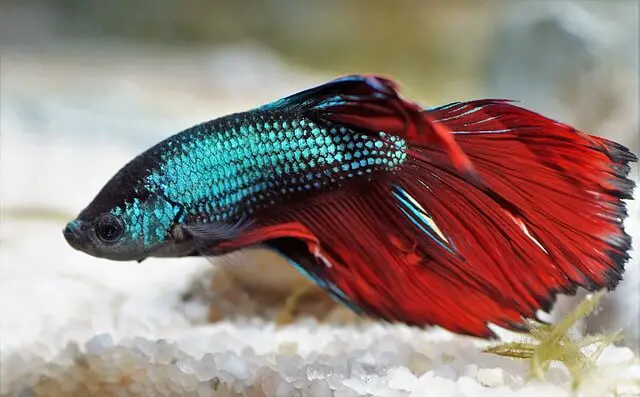Betta fish are one of the lovely fish that you would like to have in your tank. However, shredding of Betta’s fins can be a source of slight concern.
Betta fish, especially males, have a strong tendency to fight others of their kind. In this battle, their silky fins tend to get damaged and shredded. To treat this, it’s important to provide the fish with clean, mineral-filled water.
Additionally, infections on the fins can be treated by giving antifungals and antibiotics to them. Most fins, however, regenerate on their own.
Several reasons exist for Betta’s fins to look shredded. Read on to know all about them and ways to treat the issue!
Reasons Why Betta’s Fins Look Shredded And Treatment Guide

1. High levels of Toxicities in water:
For Betta fish to thrive in a tank, the Ammonia levels need to be a hard zero. The increased levels are due to the build-up of toxic wastes in the water.
These wastes include fecal discharge, shedding of fish scales naturally, and food left uneaten. These add toxicities such as Ammonia, Nitrates, and Nitrites, all of which are hazardous to the fish.
Treatment: The best way is to give the fish food in the amounts it consumes by monitoring how much food is eaten by the fish on average and setting a standard amount.
This should be done in the first week of adding the fish to the tank. Regular cleaning of the tank is also needed. Read below for detailed guidelines.
2. Stress and built-up aggression:

This is caused by heavy lighting in the tank. Such constant exposure to light stresses the fish out as they sense a lack of privacy and a “safe” spot to be temporarily out of view.
Treatment: Ensure the fish has ample space to roam around so as to not feel suffocated. Apart from this, if constantly exposed to human contact or contact with other fish, the Betta fish can get agitated, with no place of privacy.
To avoid this, set times when exposure of the fish to light is minimal and provide it with décor that acts as privacy points in the tank.
Read Recommended: Can Betta Fish Gill Be Black?
3. Fin rots:
More often than not, rotting fins are mistaken for shredded ones. This could be due to stronger than needed filtration in the tank. Apart from this, the physical abrasions faced by the Betta could be the cause of these rots.
Treatment: treatment of rotting fins with salt works best! Adding salt to the tank in low concentrations will provide the fish with a cleansing solution that will help with the rotting.
If further care is needed, the fish can be exposed to antibacterial and antifungal treatments to heal and revive the shredding tails.
Read More: Top 5 Signs To Know If Fish Rot Is Healing (With Treatment Tips)
4. Tail biting:
Some Bettas tend to bite their tails and fins. Several reasons exist for this to be the case, including:
- A problematic tank-mate
- Excessive exposure to other fish or even humans
- Unclean water conditions
- Boredom
Treatment: A number of solutions exist for these problems, including:
- Assessing the nature of your fish and allotting them in the same tank accordingly. It is best to let fish that are compatible with each other share a tank, so there is minimum fighting.
- To not let stress and anxiety build-up, avoid overcrowding your fish tank and keep from constantly being in their field of view.
- Hygiene should be a priority when maintaining any pet. For the Betta fish, set dates when you clean out the tank and take care of their hygiene needs.
- Not having open space to swim makes the Betta fish bored and therefore resort to aggressive behaviors such as tail biting. To prevent this, ensure the tank you keep them in is suitable for their athletic needs to prevent boredom.
Recommended Guide: How To Tell If It’s Fin Rot Or Fin Nipping?
5. Aquarium’s Interior:
The internal décor of your aquarium or tank could also be a cause of shredding of your Bettas fins. These include rocks, artificial plants and small pieces of wood, and other hard materials that brush against the fins.
Treatment: replace décor with sharp pointy edges with smoother, softer items. On the contrary, minimal décor is also a way to avoid the problem altogether.
6. Imbalanced Feeding:
The amount of food you provide your fish could also be a source of shredding of your Betta fins.
A lower than needed amount of food intake means your fish’s immunity will not be as strong as it needed.
Overfeeding will mean the water the fish is living in is not clean and up to the mark as it should be, further affecting its health.
Treatment: Avoid inconsistency in the time and amount of food given to your Betta. Make sure excessive feed is given in amounts that don’t go to waste.
It is best to consult pet shop owners for fish feed that has adequate minerals, vitamins, and nutrients in general, so the needs of your fish are met, improving their immunity.
7. Mucus barrier:
The mucus barrier surrounding the Betta fish is a form of shield against external barriers for the fish.
An unhealthy diet and excessive chemicals in the water lead to this barrier rupturing, exposing the fish to harsh conditions and shredding of its fins.
Treatment: Avoid adding too much chemical to the water in your Betta fish’s tank. It is best to have the water available sampled and analyzed so you are well aware of the nutrients in it and make adjustments accordingly.
Excessive micronutrients such as Chlorine and Aluminum in the water should be kept minimum.
8. Fights:

If your Betta fish shares a tank with another male, it is most likely to lose its fins to the constant fighting.
Betta fish, especially their males, have zero tolerance for other males around their surroundings. This leads to them constantly physically fighting, making them shred their fins all the time.
Some males also have a low tolerance for females and fight them if they share the same tank.
Treatment: Instead of barging into the tank with the presence of another male or female, use a week’s time to get the fish accustomed and acquainted with the sight of another fish by placing their tanks side by side, in clear view of each other.
Slowly make the change of introducing a new fish in the same habitat.
9. Unsuitable Water Temperature:
Extreme temperatures can cause your Betta fish to act out in mysterious ways that more often than not end up physically damaging the fish’s fins.
If the temperature is too high, the fish will be hyperactive and will find obsessive ways to vent that excess heat. These include burrowing their bodies in the gravel beneath or aimlessly swimming around the tank.
On the contrary, low temperatures will slow the fish’s metabolism down and will lower their immunity.
Treatment: Use a thermometer to constantly monitor the temperature in the tank. It is best to have the temperature as close to room temperature as possible, i.e., 25-26 °C (75-80 °F).
10. Traveling Injuries:
It is very likely for the Betta fish’s fins to shred during transportation. Handling the fish requires great precision and care. Neglect of these factors is seen in the shreds on the fish’s fins.
Treatment: Even though a pet owner may not have any say in the handling of the fish pre-purchase, excessive care can be provided to prevent the shredding from continuing once the fish is in its new home.
Read: Can I Touch My Fish With My Hand?
11. Variation:
New breeding strategies have led to a certain variation being observable in the Betta fish. Known as the Crowntail, this fish has a sharp resemblance to the Betta fish, with its fins and tail being distinctively shredded looking.
Treatment: No treatment is needed for this case; however, a keen eye on the fish will help you know what you have on your hands as the Crown tails fins will be shredded looking from the start with no change.
Recommended Guide: How Old Are Betta Fish At Pet Stores?
What are Relapse Infections?
During the treatment of shredding or rotting fins, the possibility exists of relapse infections. These include several bacterial infections Betta fish are likely to face during their healing process for shredding. These include:
Constipation:
This is the result of overfeeding the fish, with blockage in its excretory system. Constipated fish will eat little to no food, and an obvious absence of feces is seen in the tank.
To treat this, avoid feeding the fish for two days as it already has consumed enough, or treat by giving a single piece of frozen pea without the skin for 20 minutes, and remove the pea thereafter.
Microbial Infections:
One microbial infection is called Velvet or Gold dust illness. It is caused by parasites and is lethal, most certainly killing the entire tank if left unchecked.
Ich is another parasitic infection that is faced by Betta fish. It shows as white spots on the body of the fish and causes the fish to repeatedly rub themselves against any hard surface.
Fungal Infections:
Fungal spore formation is a common infection in many aquariums. They affect the mucus lining of the Betta fish and therefore lessens their immunity. Simple treatment is the addition of fungicides to the tank.
How to clean your betta fish tank?
Since a number of reasons for the shredding of Betta fish’s fins are due to poor tank water conditions, knowing how to provide the fish with a clean tank is essential. Detailed steps on how to get the job done are mentioned below:
- Safely remove the fish from the tank, and transfer them temporarily to a clean tank with adequate water. Remove the décor and clean it using water and white vinegar.
- Unplug the tank and keep it as far away from electricity as possible to prevent any misfortunes.
- Using a cup, remove the gravel lining the tank gently and in small quantities. Discard all but two cups of the gravel, as you need to preserve the natural bacteria that make their home in this gravel and benefit your fish.
- Move the saved cups of gravel into a sieve. Rinse the gravel using lukewarm water to remove any debris. Repeat the process until the water from the sieve runs clear.
- Repeat this process for the fresh gravel you will line in your tank. Allow both portions to dry completely.
- Using a soft scrub, clean the inside of the tank to remove any debris not wiped away with the water. This ensures no dirt or ammonia makes its way back into the clean water.
- After this, mix both the saved and new gravel. Line the tank with this mixture and replace the décor.
- Add water to the tank and fill it with almost two-thirds of the total volume of the tank. Turn on the electricity supply and place the fish back in the clean tank. Make sure the transfer is gentle and not rapid. This excessive speed of transfer can shock the fish, making it difficult for them to live in the tank.
Additional Treatment Tips
As a general treatment, use shrimps in the water in small amounts. They have a natural tendency to clean, so will help in maintaining the water quality of your tank, especially with excess food and algae.
Use reliable filters to dechlorinate the water for your fish tank. Make this a habit so as to provide your fish with water free from chlorine.
Check out this guide about the best sponge filter for betta fish.
To treat parasitic infections, increase the temperature of the tank by 5 degrees, and add anti-ich treatment. Note: this needs to be done at the free-swimming stage to ensure its success. At a later stage, the treatment will not be beneficial.
Fin rots are very common in Betta fish and can be caused by bacteria as well as fungi. Their treatment requires a separate “quarantine” tank for the fish to be kept in. It is best to have such a spare tank for emergencies to prevent the death of the fish.
Conclusion
Betta fish are an elite pet and creature as a whole. Keeping them as pets requires the utmost care for their well-being. The best way to heal the shredding of Betta fish’s fins is to do nothing and let nature do its work.
However, when needed, take the precautionary steps to ensure the health of your fish. A clean tank with adequate water and nutritious feed is the most important step.
Read More…
Hi! I’m Praveen Ghoshal, the founder of eFishkeeping.com. Inspired by my Dad, I got interested in fishkeeping when I was a kid. Since then, I have been involved with this hobby. Currently, I have 3 fish tanks at our home, and I enjoy this hobby with my full family. Read more about me here.








